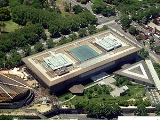
National Gallery of Victoria
Encyclopedia

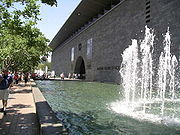

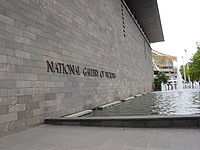
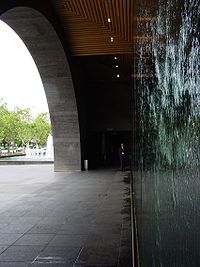
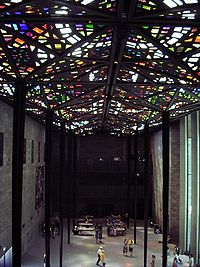
Art gallery
An art gallery or art museum is a building or space for the exhibition of art, usually visual art.Museums can be public or private, but what distinguishes a museum is the ownership of a collection...
in Melbourne, Australia. Founded in 1861, it is the oldest and the largest public art gallery in Australia. Since December 2003, NGV has operated across two sites. The main gallery, known as NGV International, is located on St Kilda Road, in the heart of the Melbourne Arts Precinct
Melbourne Arts Precinct
The Melbourne Arts Precinct is a series of galleries, performing arts venues and spaces in Melbourne, Victoria, in Australia. The precinct is situated less than 1 km from the Melbourne city centre in Southbank and is centred around, and near, St Kilda Road...
of Southbank
Southbank, Victoria
Southbank is an inner city suburb of Melbourne, Victoria, Australia located direct south of the Yarra River opposite Melbourne's Hoddle Grid. The northernmost area is considered part of the Central Business District and Central Activities District of the city. Its Local Government Area are the...
, with a branch gallery at Federation Square
Federation Square
Federation Square is a civic centre and cultural precinct in the city of Melbourne, Victoria, Australia....
. The St Kilda Road Gallery, designed by Sir Roy Grounds, opened in 1968. and redesigned by Mario Bellini. The Ian Potter Centre: NGV Australia at Federation Square was designed by LAB Architecture Studio.
At the time when the gallery opened, Victoria
Victoria (Australia)
Victoria is the second most populous state in Australia. Geographically the smallest mainland state, Victoria is bordered by New South Wales, South Australia, and Tasmania on Boundary Islet to the north, west and south respectively....
was an independent colony for just ten years, but in the wake of the Victorian gold rush
Victorian gold rush
The Victorian gold rush was a period in the history of Victoria, Australia approximately between 1851 and the late 1860s. In 10 years the Australian population nearly tripled.- Overview :During this era Victoria dominated the world's gold output...
, it was easily the richest part of Australia, and Melbourne the largest city. Besides donations of works of art, donated funds from wealthy citizens have been used by the Gallery to purchase large collections of overseas works from both old and modern masters. The Gallery currently holds over 65,000 works of art. The Felton Bequest, established by the will of Alfred Felton
Alfred Felton
Alfred Felton was an Australian entrepreneur, art collector and philanthropist.-Biography:Alfred Felton was born at Maldon, Essex, England, the fifth child of six sons and three daughters of William Felton, a currier, and his wife Hannah...
, has acquired and donated over 15,000 works of art to the Gallery.
The National Gallery of Victoria Art School
National Gallery of Victoria Art School
The National Gallery of Victoria Art School , associated with the National Gallery of Victoria, was founded in 1867. It was the leading centre for academic art training in Australia until about 1910. Among its luminaries, the school was headed by John Brack from 1962-68 and Sir William Dargie was...
, associated with the gallery, was founded in 1867. It was the leading centre for academic art training in Australia until about 1910. The School’s graduates went on to become some of Australia’s most significant artists.
Heidelberg era
In the late 19th and early 20th century, domestic art began to thrive (particularly with the "Heidelberg SchoolHeidelberg School
The Heidelberg School was an Australian art movement of the late 19th century. The movement has latterly been described as Australian Impressionism....
" in what was then an outer suburb of Melbourne) and the National Gallery was well-placed to add an excellent collection of key Australian works, which trace the metamorphosis of imported European styles into distinctively Australian art. One of the most famous works at the gallery is The pioneer
The pioneer (painting)
The pioneer is a 1904 painting by the Australian artist Frederick McCubbin. The painting is a triptych; the three panels tell a story of a free selector and his family making a life in the Australian bush...
by Frederick McCubbin
Frederick McCubbin
Frederick McCubbin was an Australian painter who was prominent in the Heidelberg School, one of the more important periods in Australia's visual arts history....
(1904).
Collection
The International Collection includes works by Gian Lorenzo BerniniGian Lorenzo Bernini
Gian Lorenzo Bernini was an Italian artist who worked principally in Rome. He was the leading sculptor of his age and also a prominent architect...
, Marco Palmezzano
Marco Palmezzano
Marco Palmezzano was an Italian painter and architect, belonging to the Forlì painting school, who painted in a style recalling earlier Northern Renaissance models, and was mostly active near Forlì.-Biography:...
, Rembrandt, Peter Paul Rubens, Giovanni Battista Tiepolo
Giovanni Battista Tiepolo
Giovanni Battista Tiepolo , also known as Gianbattista or Giambattista Tiepolo, was an Italian painter and printmaker from the Republic of Venice...
, Tintoretto
Tintoretto
Tintoretto , real name Jacopo Comin, was a Venetian painter and a notable exponent of the Renaissance school. For his phenomenal energy in painting he was termed Il Furioso...
, Paolo Uccello
Paolo Uccello
Paolo Uccello , born Paolo di Dono, was an Italian painter and a mathematician who was notable for his pioneering work on visual perspective in art. Giorgio Vasari in his book Lives of the Artists wrote that Uccello was obsessed by his interest in perspective and would stay up all night in his...
, and Paolo Veronese
Paolo Veronese
Paolo Veronese was an Italian painter of the Renaissance in Venice, famous for paintings such as The Wedding at Cana and The Feast in the House of Levi...
, amongst others. In the Modern collection, the gallery has continued to expand into new areas, becoming an early leader in textiles, fashion, photography, and Australian Aboriginal art. Today it has strong collections in areas as diverse as old masters, Greek vases, Egyptian artifacts and historical European ceramics, and the largest and most comprehensive range of artworks in Australia.
An important recent addition to the collection is "The Rest on the Flight Into Egypt with Saint Catherine and Angels" by Paris Bordone
Paris Bordone
Paris Bordon was an Italian painter of the Venetian Renaissance who, despite training with Titian, maintained a strand of mannerist complexity and provincial vigor.-Biography:...
. The purchase price was $3.8 million, the largest amount ever paid for a painting in the NGV collection.
As a "National Gallery"
The gallery's name has caused some confusion over the years, as Victoria is not, and never has been a nationNation
A nation may refer to a community of people who share a common language, culture, ethnicity, descent, and/or history. In this definition, a nation has no physical borders. However, it can also refer to people who share a common territory and government irrespective of their ethnic make-up...
, but a state of Australia, and there is also the National Gallery of Australia
National Gallery of Australia
The National Gallery of Australia is the national art gallery of Australia, holding more than 120,000 works of art. It was established in 1967 by the Australian government as a national public art gallery.- Establishment :...
(NGA) in Canberra
Canberra
Canberra is the capital city of Australia. With a population of over 345,000, it is Australia's largest inland city and the eighth-largest city overall. The city is located at the northern end of the Australian Capital Territory , south-west of Sydney, and north-east of Melbourne...
. Some people, such as the chairman of the NGA, have called for the NGV to be renamed, perhaps to "Melbourne Gallery". However, the NGV was founded some 40 years before the founding of the Commonwealth of Australia, when Victoria was a self-governing British colony; the name alludes to that period, when Victoria was a discrete political entity. It was also established more than a century before the National Gallery in Canberra. According to former Victorian Premier Steve Bracks
Steve Bracks
Stephen Philip Bracks AC is a former Australian politician and the 44th Premier of Victoria. He first won the electoral district of Williamstown in 1994 for the Australian Labor Party, and was party leader and Premier from 1999 to 2007....
, "We won't be renaming the National Gallery of Victoria. It has a great tradition. It is the biggest and best gallery in the country and it's one of the biggest and best in the world."
Ian Potter Centre and NGV International
In 1959, the commission to design a new gallery and cultural centre was awarded to the architectural firm Grounds Romberg Boyd. In 1962, Roy GroundsRoy Grounds
Sir Roy Burman Grounds , wasone of Australia's leading architects of the modern movement.-Biography:Born in Melbourne, Grounds was educated at Scotch College and then Melbourne University and worked for the architectural firm of Blackett, Forster and Craig...
split from his partners Frederick Romberg
Frederick Romberg
Frederick Romberg, , born on June 21, 1913 in Tsingtao, China, is a Swiss-trained architect who migrated to Australia in 1938....
and Robin Boyd
Robin Boyd
Robin Gerard Penleigh Boyd CBE was an influential Australian architect, writer, teacher and social commentator...
, retained the commission, and designed the gallery at 180 St Kilda Road (now known as NGV International). The building was completed in December 1967 and opened on 20 August 1968. One of the features of the gallery buildings are famous for is the Leonard French
Leonard French
Leonard William French OBE is an Australian artist, known principally for major stained glass works.French was born in Brunswick, Victoria...
ceiling, one of the world's largest pieces of suspended stained glass. The ceiling casts colourful light on the floor below. Grounds subsequently designed the adjacent Victorian Arts Centre with its iconic spire.
The gallery is now spread over two buildings a short distance from each other at the southern end of the CBD. A new space, The Ian Potter Centre, in Federation Square
Federation Square
Federation Square is a civic centre and cultural precinct in the city of Melbourne, Victoria, Australia....
opened in 2003 and houses the Australian art collection. Grounds' building just south of the Yarra River
Yarra River
The Yarra River, originally Birrarung, is a river in east-central Victoria, Australia. The lower stretches of the river is where the city of Melbourne was established in 1835 and today Greater Melbourne dominates and influences the landscape of its lower reaches...
now houses the international collection. It reopened in December 2003 after four years of renovations by architect Mario Bellini
Mario Bellini
Mario Bellini is a world renowned Italian architect and designer.He graduated from the Milan Polytechnic - Faculty of Architecture in 1959 and began working as an architect himself in the early 1960s...
.
The iconic Angel sculpture by Deborah Halpern
Deborah Halpern
Deborah Halpern is an artist working in Victoria Australia, notable for her prominent and popular works of public art. Halpern is a sculptor, mosaic artist and ceramic artist...
was removed to be restored and relocated to Birrarung Marr. The Australian collection includes a large number of works donated by Dr. Joseph Brown
Joseph Brown (artist)
Joseph Brown, AO, OBE was an Australian artist and art collector.Brown was born in Poland in 1918 and migrated to Australia in 1933 at the age of fifteen, settling in Melbourne. He trained initially as an artist but after returning from war service in 1945 became increasingly involved in the...
in 2004, which forms the Joseph Brown Collection
Joseph Brown Collection
The Joseph Brown Collection comprises works of art donated to the National Gallery of Victoria in 2004 by the collector and art dealer Joseph Brown. The collection is displayed in the Ian Potter Centre, part of the NGV...
.
Picasso theft
A famous event in the history of the gallery was the theft of Pablo PicassoPablo Picasso
Pablo Diego José Francisco de Paula Juan Nepomuceno María de los Remedios Cipriano de la Santísima Trinidad Ruiz y Picasso known as Pablo Ruiz Picasso was a Spanish expatriate painter, sculptor, printmaker, ceramicist, and stage designer, one of the greatest and most influential artists of the...
's painting "The Weeping Woman
The Weeping Woman
Weeping Woman , is an oil on canvas painted by Pablo Picasso in France, 1937. Picasso was intrigued with the subject, and revisited the theme numerous times that year. This painting was the final and most elaborate of the series...
" in 1986 by a person or group who identified themselves as the "Australian Cultural Terrorists". The group took the painting to protest the perceived poor treatment of the arts by the state government of the time and sought as a ransom the establishment of an art prize for young artists. The painting was returned in a railway locker a week later.
Blockbusters
The National Gallery of Victoria has held several large exhibitions known as "blockbusters", starting with Impressionists: Masterpieces from the Musee d'Orsay in 2004, and an exhibition of Dutch masters in winter 2005 with Vermeer's painting The Love LetterWoman in Blue Reading a Letter
Woman in Blue Reading a Letter is a painting by the Dutch painter Johannes Vermeer. Part of the collection of the Rijksmuseum Amsterdam since 1885, it was the first Vermeer acquired by the museum.-Composition:...
from the Rijksmuseum in Amsterdam
Amsterdam
Amsterdam is the largest city and the capital of the Netherlands. The current position of Amsterdam as capital city of the Kingdom of the Netherlands is governed by the constitution of August 24, 1815 and its successors. Amsterdam has a population of 783,364 within city limits, an urban population...
exhibited among many others. It was the first time a Vermeer painting had been exhibited in Australia. There was also an exhibition of Caravaggio
Caravaggio
Michelangelo Merisi da Caravaggio was an Italian artist active in Rome, Naples, Malta, and Sicily between 1593 and 1610. His paintings, which combine a realistic observation of the human state, both physical and emotional, with a dramatic use of lighting, had a formative influence on the Baroque...
paintings in 2004.
The 2006 Melbourne Winter Masterpieces exhibition was titled Picasso: Love and War 1935-1945 and ran from 30 June 2006 and 8 October 2006. The exhibition of over 300 Picasso drawings and paintings from the years 1935-1945 was curated by Anne Baldassari, Director of the Musée Picasso
Musée Picasso
The Musée Picasso is an art gallery located in the Hôtel Salé in rue de Thorigny, in the Marais district of Paris dedicated to the work of the artist Pablo Picasso .-Building:...
, Paris
Paris
Paris is the capital and largest city in France, situated on the river Seine, in northern France, at the heart of the Île-de-France region...
.
The 2007 Melbourne Winter Masterpieces exhibition was titled "Guggenheim Collection 1940s to now" (30 June to 7 October 2007) and showed more than 85 works by 68 artists, mainly from the Solomon R. Guggenheim Museum
Solomon R. Guggenheim Museum
The Solomon R. Guggenheim Museum is a well-known museum located on the Upper East Side of Manhattan in New York City, United States. It is the permanent home to a renowned collection of Impressionist, Post-Impressionist, early Modern, and contemporary art and also features special exhibitions...
, New York City
New York City
New York is the most populous city in the United States and the center of the New York Metropolitan Area, one of the most populous metropolitan areas in the world. New York exerts a significant impact upon global commerce, finance, media, art, fashion, research, technology, education, and...
, but also from other Guggenheim Museums in Venice
Peggy Guggenheim Collection
The Peggy Guggenheim Collection is an art museum on the Grand Canal in Venice, Italy. It is one of several museums of the Solomon R. Guggenheim Foundation....
, Bilbao
Guggenheim Museum Bilbao
The Guggenheim Museum Bilbao is a museum of modern and contemporary art, designed by Canadian-American architect Frank Gehry, built by Ferrovial, and located in Bilbao, Basque Country, Spain. It is built alongside the Nervion River, which runs through the city of Bilbao to the Atlantic Coast. The...
, and Berlin
Berlin
Berlin is the capital city of Germany and is one of the 16 states of Germany. With a population of 3.45 million people, Berlin is Germany's largest city. It is the second most populous city proper and the seventh most populous urban area in the European Union...
. The exhibition did not travel to any other city; it was seen by more than 180,000 visitors.
The 2008 Melbourne Winter Masterpieces exhibition was titled "Art Deco
Art Deco
Art deco , or deco, is an eclectic artistic and design style that began in Paris in the 1920s and flourished internationally throughout the 1930s, into the World War II era. The style influenced all areas of design, including architecture and interior design, industrial design, fashion and...
1910—1939" and ran from 28 June to 5 October 2008. The exhibition was organized by the Victoria and Albert Museum
Victoria and Albert Museum
The Victoria and Albert Museum , set in the Brompton district of The Royal Borough of Kensington and Chelsea, London, England, is the world's largest museum of decorative arts and design, housing a permanent collection of over 4.5 million objects...
, London.
The 2009 Melbourne Winter Masterpieces exhibition was titled "Salvador Dalí
Salvador Dalí
Salvador Domènec Felip Jacint Dalí i Domènech, Marquis de Púbol , commonly known as Salvador Dalí , was a prominent Spanish Catalan surrealist painter born in Figueres,Spain....
Liquid Desire" and ran from 13 June to 4 October 2009.
The 2011 Melbourne Winter Masterpieces exhibition was titled "Vienna
Vienna
Vienna is the capital and largest city of the Republic of Austria and one of the nine states of Austria. Vienna is Austria's primary city, with a population of about 1.723 million , and is by far the largest city in Austria, as well as its cultural, economic, and political centre...
Art and Design" and ran from 13 June to 4 October 2011.
Directors of the NGV
Directors of the NGV since its inception:- G. F. Folingsby, 1882–91
- Lindsay Bernard HallLindsay Bernard HallLindsay Bernard Hall was an English-born Australian artist and art gallery director.Hall was born at Garston, Liverpool, England, the son of a broker of the same family as Captain Basil Hall, writer of books of travel. Hall was well educated and grew up in an atmosphere of culture...
, 1891-35 - William Beckwith McInnesWilliam Beckwith McInnesWilliam Beckwith McInnes was an Australian portrait painter, winner of the Archibald Prize seven times for his traditional style paintings.-Early life:...
, (acting) 1935-36 - P. M. Carew-Smyth, (acting) 1937
- J. S. MacdonaldJames Stuart MacDonaldJames Stuart MacDonald was an Australian artist, art critic and Director of the National Art Gallery of New South Wales from 1929 to 1937.-Early life:...
, 1936–41 - Daryl LindsayDaryl LindsaySir Ernest Daryl Lindsay was an Australian artist and member of the creative Lindsay family.-Early life:...
, 1942–55 - Eric Westbrook, 1956–73
- Gordon Thomson (administrator), 1973–74
- Eric Rowlison, 1975–80
- Patrick McCaughey, 1981–87
- Rodney Wilson, 1988
- James MollisonJames MollisonJames Mollison, AO, was Acting Director of the National Gallery of Australia from 1971 to 1977 and Director from 1977 – 1990. He was Director of the National Gallery of Victoria from 1989 to 1995....
, 1989–95 - Timothy PottsTimothy PottsDr Timothy Potts is an Australian art historian, archaeologist, and museum director.- Biography :Timothy Potts was educated at the University of Sydney and holds a DPhil in Near Eastern art and archaeology from the University of Oxford, where he was a research lecturer and British Academy Research...
, 1995–98 - Gerard Vaughan, 1999-

